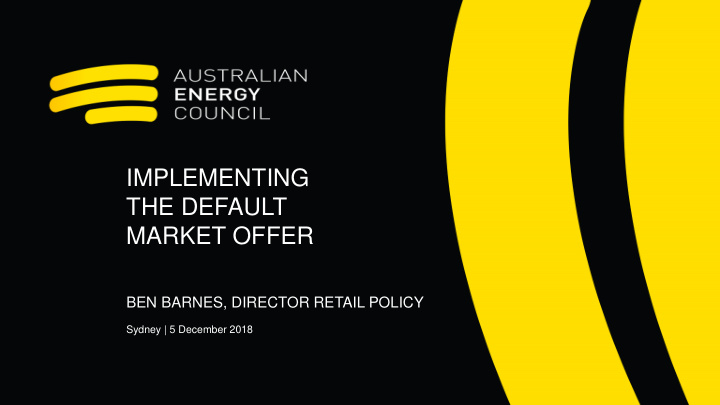



IMPLEMENTING THE DEFAULT MARKET OFFER BEN BARNES, DIRECTOR RETAIL POLICY Sydney | 5 December 2018
OBJECTIVE OF THE DEFAULT OFFER • Both Thwaites and the ACCC considered the Standing Offer was no longer serving its intended purpose • Both proposed removing it, and replacing it with an almost identical regulatory construct, albeit with a different price capping mechanism • The Default Market Offer was described as having two benefits: • it will act as a cap for the price of default offers to limit the ‘loyalty tax’ that is levied on disengaged consumers • it will be used to calculate a reference bill amount which all discounts must be taken from • These two benefits have been conflated in the public debate December 2018
THE KEY FEATURES OF A WORKABLY COMPETITIVE RETAIL ELECTRICITY MARKET • It should incentivise service providers to innovate by providing a range of products and services that customers express a willingness to pay for; • It should place downward pressure on overall costs and therefore prices, as retailers seek to retain or gain market share by helping customers reduce their electricity costs; • It should lead to retail electricity prices that maximise economic welfare (producer and consumer surplus); • It should minimise the transaction costs incurred by buyers and sellers interacting with the market; and • It should provide easy access to relevant information and minimise information asymmetries. November 2018
SETTING A PRICE CAP The impact of the default market offer will depend in part on what: • cost categories the regulator is required to incorporate (or not incorporate as the case may be) into its calculation, and • the level those costs are set at. • How these questions are answered will determine the type of price cap that would be applied • We see three possible alternatives • A basic service offer • Including CARC as well as headroom • Efficient CTS, plus efficient CARC December 2018
TRANSLATING THE PRICE CAP INTO A DMO • Once you determine the appropriate methodology to determine price cap, you then need to work out how to implement that into practice. The process requires: 1. The AER to determine a single DMO for each jurisdiction 2. The AER to determine three representative customer classes • A single residential flat profile • A single residential profile with controlled load • A single SME flat profile 3. The retailer to translate each DMO into a tariff (or tariffs) that existing standing offer customers will be billed on 4. Standing offer customers are notified of a price change prior to 1 July 2019 November 2018
THE RISKS OF SETTING A SINGLE PRICE • The ACCC Inquiry suggested that the DMO would represent the maximum amount a retailer could charge a default offer customer in each jurisdiction. • The AER has proposed that this would be shown as a single maximum amount for a representative customer. • The retailer would then be empowered to calibrate the DMO into a fixed and variable component • We agree with the AER that this results in lower risks for retailers than capping particular tariff components, but it will clearly result in negative consequences for some consumers November 2018
THE RISKS OF SETTING A SINGLE PRICE Case Study: The AER determines the flat tariff DMO in the Ausgrid network to be $3000 for a 5000 kWh per annum customer. Retailer 1 prices their offer at $1.50 per day , and 29c per kWh . Retailer 2 prices their offer at $1 per day , and 33c per kWh . The below table highlights the impacts this will have on customers with varying consumption. The low consumer is significantly better off with Retailer 2, and the high consumer significantly better off with retailer 1. Annual consumption Retailer 1 Retailer 2 1500kwh $982.50 $855.50 5000kWh $1,997.50 $2,000.00 8000kWh $2,867.50 $2,981.00 December 2018
THE DMO FOR SME CUSTOMERS • The AER has been tasked with developing a DMO for both residential and SME customers. • The issues for residential customers are exponentially worse for SME customers. Small Customers can consume up to 160MWh per annum in some states, while others may only consume a few thousand kWh’s. • The AER proposes to set a flat DMO, despite almost 50% of customers being on more cost reflective tariffs • The retailer would then be required to calibrate the DMO into tariffs, likely reflecting the customers network tariff. This would include customers on peak demand tariffs. It remains to be seen how this would work in practice, and the risk of unintended consequences is very high. November 2018
WHERE TO FROM HERE? • Industry is committed to making the market less confusing for consumers to engage • We know it is difficult to compare offers, and the crucial second limb of the DMO can be delivered without a regulated price cap • We have developed a voluntary comparison rate model that will enable Recommendation 32 to be implemented ASAP, hopefully Q1 2019 • The technical detail of this model will be finalised this week, to be published soon after. From there, consumer testing will be conducted to ensure it delivers our objective, making it easier for customers to engage in the market and find the best deals. November 2018
Recommend
More recommend